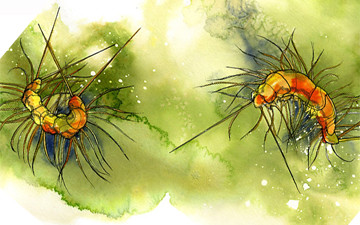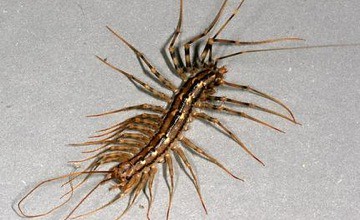Scutigera coleoptrata (one of several species commonly known as the house centipede), is a typically yellowish-grey centipede with 15 pairs of legs. Originally endemic to the Mediterranean region, the species has spread to other parts of the world, where it usually lives in human homes. It is an insectivore; it kills and eats other arthropods such as insects and arachnids. It is sometimes mistakenly identified as a “silverfish“, although the two species are quite distinct.
House centipedes feed on spiders, bedbugs, termites, cockroaches, silverfish, ants, and other household arthropods. They administer venom through modified legs. These are not part of their mandibles, so strictly speaking they sting rather than bite. They are mostly nocturnal hunters. Despite their developed eyes they seem to rely mostly on their antennae when hunting. Their antennae are sensitive to both smells and tactile information. They use both their mandibles and their legs for holding prey. This way they can deal with several small insects at the same time. To capture prey they either jump onto it or use their legs in a technique described as “lassoing”. Using their legs to beat prey has also been described.[3] In a feeding study, S. coleoptrata showed the ability to distinguish between possible prey. They avoid dangerous insects. They also adapted their feeding pattern to the hazard the prey might pose to them. For wasps, they retreat after applying the venom to give it time to take effect.[3] When the centipede is in danger of becoming prey itself, it can detach any legs that have become trapped.
House centipedes lay their eggs in spring. As with many other arthropods, the larvae look like miniature versions of the adult, albeit with fewer legs. Young centipedes have four pairs of legs when they are hatched.
They live anywhere from three to seven years, depending on the environment.
(Text from Wikipedia, 14 May 2011)





